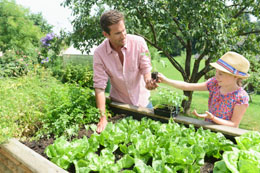French intensive gardening is a good way of getting maximum yield from a small space. Read on to know more about this method...

As the name suggests, the method was developed in France, from where it spread to other parts of Europe, and the world. This method is also known as biodynamic agriculture, the Marais system, and square-foot gardening. The main objective behind this method is to generate maximum yield in the least amount of space. Although this method defies certain preconceived notions about agriculture and farming, it is highly effective and efficient.
What is It, Exactly?
It is a method invented to gain the maximum possible yield with the help of particular changes in the garden layout, and using certain agricultural techniques. Planning is extremely important here, as the type of crop and method of planting need to be carefully determined well in advance.
A unique aspect is the use of raised beds. The gardening beds are huge, which allows people to walk through the entire area in order to maintain the garden. The beds are dug up twice, which means that the soil below is loose and worked up. Due to this, light and fluffy soil is generated, which is then improved by the addition of humus and compost, leading to a respectable plant growth with wide and deep roots.
Establishing these kinds of beds takes a lot of effort, but people feel it is worth it, as the yield is excellent. To maintain the bed, it has to be watered lightly everyday, along with regularly adding compost and fertilizers.
Plant spacing is another important feature here. Plants are grown in proximity to each other, which ensures that the soil stays moist, and prevents unwanted weed growth.
Methods
Catch Cropping
As per the climatic conditions, it takes a few months to harvest a crop in the same place where a crop was previously harvested. During this period, fast-growing crops like radish, onions, or lettuce can be grown to utilize the idle space.
Inter-cropping
In this method, a fast-maturing crop is planted between rows of crops that grow slowly. Crops like onions, lettuce or radish can be planted between (or within) rows of slow-maturing plants like cabbage, tomatoes, or broccoli.
Succession Planting
This method involves planting the same quick-maturing crop over a period of 1 to 4 weeks. Plant one row of a crop, and leave some space around the planting which can be used later. After every passing week, plant one more row of the same plant. Subsequently, when one row is harvested, the second will be ready, and so on. This will ensure a consistent supply of vegetables all through the season.
Relay Planting
In relay planting, an altogether different crop is planted in the same space where a crop is just about to mature. This means that when the preexisting crop is harvested, the crop planted later has got an advantage. Thus, more crops can be planted in the same space all through the year.
Wide Row Planting
A variation of the inter-cropping method, wide row planting involves planting in groups or rows about 1 to 4 feet wide. Although walking space between the rows reduces, this method facilitates economic use of fertilizers and water. Also, it is tougher for weeds to grow in this kind of an arrangement. Make grids, so that it becomes easier for marking out sections and enables proper utilization of space.
It should be noted that this method is not for people who pursue gardening as a hobby. Rather, only those who are hardworking and dedicated towards gardening should start it. It involves hard work, especially in the preparation and maintenance of the raised beds, so only dedicated gardeners should try this method.






 As the name suggests, the method was developed in France, from where it spread to other parts of Europe, and the world. This method is also known as biodynamic agriculture, the Marais system, and square-foot gardening. The main objective behind this method is to generate maximum yield in the least amount of space. Although this method defies certain preconceived notions about agriculture and farming, it is highly effective and efficient.
As the name suggests, the method was developed in France, from where it spread to other parts of Europe, and the world. This method is also known as biodynamic agriculture, the Marais system, and square-foot gardening. The main objective behind this method is to generate maximum yield in the least amount of space. Although this method defies certain preconceived notions about agriculture and farming, it is highly effective and efficient.